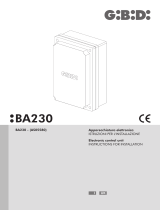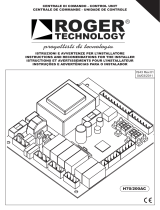
MONTAGEANLEITUNG
3) VORBEREITUNG LEITUNGEN Fig. A
Bereiten Sie die elektrische Anlage vor und nehmen Sie dabei auf die geltenden
Bestimmungen für elektrische Anlagen CEI 64-8, IEC364, Harmonisierung HD384
sowie die sonstigen nationalen Normen Bezug.
4) ANSCHLÜSSE KLEMMLEISTE Fig. B
HINWEISE - Bitte beachten Sie bei den Verkabelungs- und Installationsarbeiten
die geltenden Bestimmungen sowie die Regeln der guten Technik.
Die Leiter, die mit unterschiedlichen Spannungen gespeist werden, müssen physisch
voneinander getrennt oder mit zusätzlichen Isolierungen von zumindest 1 mm
isoliert werden. Die Leiter müssen in der Nähe der Klemmen an einer zusätzlichen
Befestigung verankert werden, zum Beispiel mit Kabelbindern. Alle Verbindungskabel
müssen vom Dissipator ferngehalten werden.
ACHTUNG! Verwenden Sie für den Anschluss an das Stromnetz mehradrige
Kabel mit einem Mindestquerschnitt von 3 x 1,5 mm² vom Typ, der von den
geltenden Bestimmungen vorgeschrieben wird. Verwenden Sie für den
Anschluss der Motoren Kabel mit einem Mindestquerschnitt von 1,5 mm²
vom Typ, der von den geltenden Bestimmungen vorgeschrieben wird. Das
Kabel muss zumindest H05RN-F sein.
5) SICHERHEITSVORRICHTUNGEN
Anmerkung: Nur empfangende Sicherheitsvorrichtungen mit freiem
Austauschkontakt verwenden.
5.1) ÜBERPRÜFTE GERÄTE Fig. G
5.2) ANSCHLUSS VON 1 FOTOZELLENPAAR NICHT ÜBERPRÜFT Abb. C1
5.3) ANSCHLUSS VON 1 FOTOZELLENPAAR ÜBERPRÜFT Abb. C2
ACHTUNG!
Die von der Norm EN 12453 vorgeschriebenen Werte der Aufprallkräfte wer-
den nur eingehalten, wenn (aktive) Tastleisten an die Karte angeschlossen
sind.
6 EINSTELLVERFAHREN
- Überprüfen Sie vor dem Einschalten die elektrischen Anschlüsse.
- Stellen Sie die Anschläge (falls vorhanden) ein.
- Führen Sie einen Autoset aus, um die Arbeitszeit einzustellen.
- Nehmen Sie die Einstellung der Trimmpotentiometer vor.
- nehmen sie die Einstellung der DIP-Switches vor.
ACHTUNG! Ein falsche Einstellung kann zur Verletzung von Personen oder
Tieren sowie zu Sachschäden führen.
7 ABSPEICHERUNG FERNBEDIENUNG FIG. D
MENÜ FUNK radio
- WICHTIGER HINWEIS: KENNZEICHNEN SIE DEN ERSTEN ABGESPEICHERTEN
SENDER MIT DER SCHLÜSSEL-MARKE (MASTER).
Bei der manuellen Programmierung vergibt der erste Sender den SCHLÜSSELCODE
DES EMPFÄNGERS; dieser Code ist für das anschließende Clonen der
Funkbedienungen erforderlich.
Der eingebaute Empfänger Clonix weist außerdem einige wichtige erweiterte
Funktionen auf:
• Clonen des Master-Senders (Rolling-Code oder fester Code)
• Clonen zur Ersetzung von bereits in den Empfänger eingegebenen Sendern
Bitte nehmen Sie für die Benutzung dieser erweiterten Funktionen auf die
Anleitung des Universal-Programmiergeräts und die allgemeine Anleitung für
die Programmierung der Empfänger Bezug.
8) EINSTELLUNG AUTOSET
Gestattet die automatische Einstellung der Arbeitszeit der Motoren.
Es werden die Betriebszeiten, die erforderlich sind, um ein Önungs- und
Schließmanöver an beiden Motoren durchzuführen, gemessen Die gemessenen
Zeiten werden gespeichert und um eine Sicherheitszeit erhöht, um ein vollständi-
ges Önen oder Schließen zu gewährleisten, auch wenn die Motorleistung variiert.
ACHTUNG! Die Operation Autoset wird nach der Überprüfung der
ordnungsgemäßen Bewegung des Flügels (Önung/Schließung) sowie
des ordnungsgemäßen Positionierung der Anschläge und der Endschalter
ausgeführt.
ACHTUNG! Während der Autoset-Phase führen alle Aktivierungen von
Fotozellen Oder Sicherheitsleisten zum Fehlschlagen und zum Verlassen
der Autoset-Funktion.
ACHTUNG! Die Autoset-Manöver werden mit Betriebsgeschwindigkeit
ausgeführt, nicht mit Verlangsamungsgeschwindigkeit.
Autoset-Phasen für Motoren mit Endschalter (Fig. D1):
1 - Bringen Sie die Torügel an die Endschalter Schließung.
2 - Drücken Sie für 5 Sekunden die Taste S3; die LED SET blinkt.
3 - Drücken Sie die Taste S3, um das Önungsmanöver des Motors 1 zu starten.
4 - Warten Sie ab, bis der Endschalter Önung eingreift, oder drückt Sie die
Taste S3, um das Önungsmanöver des Motors 1 zu beenden.
5 - Automatisch startet das Önungsmanöver des Motors 2.
6 - Warten Sie ab, bis der Endschalter Önung eingreift, oder drückt Sie die
Taste S3, um das Önungsmanöver des Motors 2 zu beenden.
7 - Drücken Sie die Taste S3, um das Schließungsmanöver des Motors 2 zu
starten.
8 - Warten Sie ab, bis der Endschalter Schließung eingreift, oder drückt Sie die
Taste S3, um das Schließungsmanöver des Motors 2 zu beenden.
9 - Automatisch startet das Schließungsmanöver des Motors 1.
10 - Warten Sie ab, bis der Endschalter Schließung eingreift, oder drückt Sie die
Taste S3, um das Schließungsmanöver des Motors 1 zu beenden.
11 - Wenn die Arbeitszeit korrekt abgespeichert worden ist, leuchtet die LED
SET für 10 Sekunden ununterbrochen auf.
Falls das Autoset fehlschlägt, blinkt die LED SET für 10 Sekunden schnell auf.
Falls ein aktiver Motor eingestellt ist, werden die Phasen für den Motor 2 nicht
ausgeführt.
Autoset-Phasen für Motoren ohne Endschalter (Fig. D2):
1 - Bringen Sie die Torügel an den Endschalter Schließung des Tors.
2 - Drücken Sie für 5 Sekunden die Taste S3; die LED SET blinkt.
3 - Drücken Sie die Taste S3, um das Önungsmanöver des Motors 1 zu starten.
4 - Drücken Sie die Taste S3, um das Önungsmanöver des Motors 1 zu beenden.
5 - Automatisch startet das Önungsmanöver des Motors 2.
6 - Drücken Sie die Taste S3, um das Önungsmanöver des Motors 2 zu beenden.
7 - Drücken Sie die Taste S3, um das Schließungsmanöver des Motors 2 zu
starten.
8 - Drücken Sie die Taste S3, um das Schließungsmanöver des Motors 2 zu
beenden.
9 - Automatisch startet das Schließungsmanöver des Motors 1.
10 - Drücken Sie die Taste S3, um das Schließungsmanöver des Motors 1 zu
beenden.
11 - Wenn die Arbeitszeit korrekt abgespeichert worden ist, leuchtet die LED
SET für 10 Sekunden ununterbrochen auf.
Falls das Autoset fehlschlägt, blinkt die LED SET für 10 Sekunden schnell auf.
Falls ein aktiver Motor eingestellt ist, werden die Phasen für den Motor 2 nicht
ausgeführt.
9) INVERSION DER ÖFFNUNGSRICHTUNG (Fig.E)
10) ELEKTROSCHLOSS FIG. F1-F2
ACHTUNG: Bei Torügeln mit einer Länge von mehr als 3 m muss ein
Elektroschloss installiert werden.
TASTEN
TASTEN Beschreibung
S1 Hinzufügen Taste Start
Ordnet die gewünschte Taste dem Befehl Start zu
S2 Hinzufügen Taste Fußgänger
Ordnet die gewünschte Taste dem Befehl Fußgänger zu
S2
> 5s
Bestätigt die an der Einstellung der Parameter und der Funktion-
slogiken vorgenommenen Änderungen
S1+ S2
> 10s
Liste löschen
ACHTUNG! Entfernt alle abgespeicherten Fernbedienungen
vollständig aus dem Speicher des Empfängers.
S3
Ein KURZES Drücken löst einen START aus.
Das LÄNGERE Drücken (> 5 s) aktiviert den AUTOSET.
Längeres Drücken (> 10 Sekunden) stellt die Arbeitszeit auf den
Defaultwert zurück
LEDANZEIGEN:
POWER Bleibt an: - Netz vorhanden - Karte gespeist - Sicherungen intakt
START An: aktivierung Eingang START
OPEN An: aktivierung Eingang OPEN
STOP Aus: aktivierung Eingang STOP
PHOT Aus: aktivierung Eingang Fotozelle PHOT
FAULT 1 Diagnose des Eingangs Überprüfung Sicherheit Eingang PHOT
BAR Aus: Aktivierung Eingang Tastleiste BAR
FAULT 2 Diagnose des Eingangs Überprüfung Sicherheit Eingang BAR
SWC1
An: Der Endschalter Schließung des Motors 1 ist frei.
Aus: Aktivierung Eingang Endschalter Schließung des Motors 1
Blinken: Ende Arbeitszeit Schließung
SWO1
An: Der Endschalter Önung des Motors 1 ist frei.
Aus: Aktivierung Eingang Endschalter Önung des Motors 1
Blinken: Ende Arbeitszeit Önung
SWC2
An: Der Endschalter Schließung des Motors 2 ist frei.
Aus: Aktivierung Eingang Endschalter Schließung des Motors 2
Blinken: Ende Arbeitszeit Schließung
SWO2
An: Der Endschalter Önung des Motors 2 ist frei.
Aus: Aktivierung Eingang Endschalter Önung des Motors 2
Blinken: Ende Arbeitszeit Önung
ERR Aus: kein Fehler
AN: siehe Tabelle Fehlerdiagnose
RADIO
(GRÜN)
Aus: Funkprogrammierung deaktiviert
Nur LED Radio blinkend: Funkprogrammierung aktiv, warten
versteckte Taste.
Synchron mit LED Set blinkend: Löschen der Funkbefehle läuft
An: Funkprogrammierung aktiv, warten gewünschte Taste.
An 1s: Aktivierung des Kanals des Funkempfängers
SET AN: siehe Tabelle Fehlerdiagnose
Synchron mit LED Radio blinkend: Löschen der Funkbefehle läuft
ACHTUNG: Stellen Sie sicher, dass der Wert der Kraft, gemessen an den
gemäß Norm EN 12445 vorgesehenen Punkte, kleiner als der in der
Norm EN 12453 angegeben ist.
Wir empfehlen, zur Erzielung eines besseren Resultats den Autoset mit Motoren in
Ruhestellung vorzunehmen (das heißt nicht überhitzt von einer größeren Anzahl
20 - ALENA SW2 CPEM
D814078 0AA00_04


























